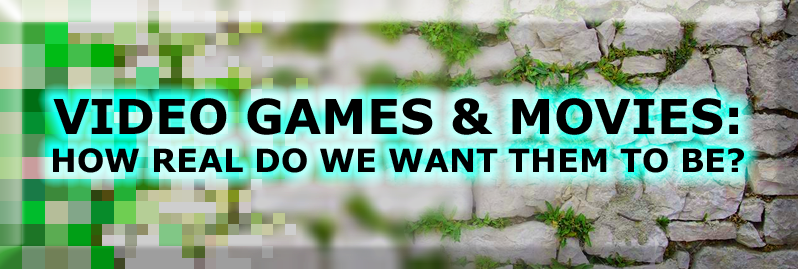

© Written by Rob Ager July 2014
CHAPTER FIVE
SUBTITLES AND COMMUNICATIVE GRAPHICS
There was once a time when foreign movies were mostly dubbed, sometimes with hilarious results, but that blatantly unrealistic facet of movies was then almost universally replaced with … another unrealistic facet.
Completely mismatching reality again, yet widely accepted in both movies and games today, is the presence of written text on the screen. We listen to characters talk in other languages while we read subtitle translations at the bottom of the screen. This doesn’t happen in life and is no more real than the stupid voiceover dubs we used to watch. Some movies extend this process of presenting information in a completely unrealistic form by showing us split screens so we can see more than one event at a time. Others show scenes dissolve into each other, which doesn’t happen at all in reality. Then we have other mismatches with reality such as screen wipes, black and white footage, negative footage, slow motion, speeded up footage, and of course mood music. How many times have you seen a fight in real life that was accompanied by drum rolls?
These kinds of facets in film language are useful because they allow film makers to communicate, or sometimes impose, plot information and moods that otherwise would take much longer to communicate if the films were strictly conforming to reality. One of my favourite examples of this kind of unrealistic yet useful sensory communication is the scene from Raiders of the Lost Ark in which we’re shown a red line representing a plane making a journey across a map, quickly establishing a location transition in the story. No dialogue. Straight to the point so to speak.
With video games the presentation of information overlaying the screen is essential. We have health bars, ammo counters, radars and all other manners of graphical display to help us both understand what is happening and interact. It is possible to make a game that does away with these informational displays, but imagine how frustrating it would be trying to anticipate how much health you have left during a fight.
Although these kinds of details are things that don’t happen at all in our daily experience of reality itself, we do process information in our minds using complex visual and auditory representations that in many cases are not unlike the menus and counters seen in video games. It’s long been established that good spellers process words visually – they see the words in their minds’ eye, where as bad spellers are usually spelling phonetically and thus getting it wrong. I mean you can’t even spell phonetic phonetically.
This is a key point in our study of so-called realism in games and movies. Our reality is not just about direct sensory input from the outside world. We also process information internally and represent that processing with internal imagery, sound and dialogue that is very unlike what we sense in the external world. Have you ever heard people speak in sensory metaphors such as feeling bright, not being able to grasp a concept, or hearing an idea that resonates with them? These aren’t just sayings. They are very often representations of how people process information in their mind. In NLP (Neuro-Linguistic Programming) these representations are called submodalities. Take a person who wants to get some distance from a worrying issue and have them visualize the thing that is bothering them on a distant tv screen in their mind with the sound turned low and the color saturated and you’ll often find that those individuals are then able to think more calmly and rationally about whatever it was that was bothering them. M ovies and video games can tap into some of these internal information processing habits, thus connecting with us in ways that are much more meaningful than simply trying to imitate our external sensory experiences.
Yet another sensory break from reality, communicated through graphical displays, is that with movies and games we’re able to adjust volume, brightness and other details manually. So a gun shot or explosion that would be deafening in reality becomes easily bearable and a bright light source like the sun becomes duller than a 40w light bulb. In fact if you switch on your tv and look at black footage it in the dark it’s still visible because it isn’t actually black. It’s a sort of dark grey.
The popularity of cartoons and CGI movies is a strong indicator that realism is not an audience priority. Cartoons serve a function of reducing visual reality to a much simpler version that is probably closer to the way we create imaginary experiences in our minds. There is reduced texture and shading, much more simplistic environments, and exaggerated facial expressions and body language. Cartoons made for toddlers are excellent examples of what could be referred to as experience simplification, but that process is also at work in Pixar movies made for families and, in subtler forms, is even present in the most mature movie content for adult audiences. Reality is a complex cluttered experience, and so a key appeal of movies and games is that they offer an alternative experience that is simplified and condensed.